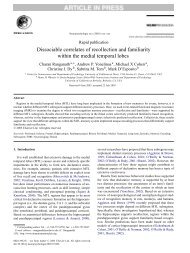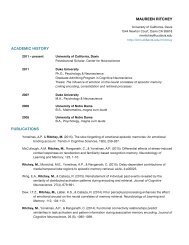CLINICAL EEG and NEUROSCIENCE - Dynamic Memory Lab
CLINICAL EEG and NEUROSCIENCE - Dynamic Memory Lab
CLINICAL EEG and NEUROSCIENCE - Dynamic Memory Lab
Create successful ePaper yourself
Turn your PDF publications into a flip-book with our unique Google optimized e-Paper software.
<strong>CLINICAL</strong> <strong>EEG</strong> <strong>and</strong> <strong>NEUROSCIENCE</strong> ©2007 VOL. 38 NO. 1Special IssueThe Electrophysiology of <strong>Memory</strong>: Section IIClinical StudiesExploring Human <strong>Memory</strong> ProcessesWith Event-Related PotentialsThomas Grunwald <strong>and</strong> Charan Ranganath, Guest EditorsWelcome to the second in our two-part special issue onthe electrophysiology of memory. In the first installment, weincluded papers reviewing recent findings from studiesaddressing basic questions about human memoryprocesses. In this issue, we will consider electrophysiologicalstudies of memory processes in special populations.As Gabriel García Márquez stated in his epigraph toLiving to Tell the Tale, “life is not what one lived, but whatone remembers (…)”. Indeed, memory functions are criticalfor almost every facet of daily life. Unfortunately memoriesare fragile, <strong>and</strong> memory functioning is highly susceptibleto deterioration through disease or injury. Such memorydeficits can have tragic effects on one’s quality of life.Fortunately, results from event-related potential (ERP)studies have revealed significant insights into the nature ofmemory disorders. ERPs can help to identify time-criticalneuronal processes <strong>and</strong> to relate them to specific cognitiveprocesses. Likewise, ERPs can help delineate functionaldeficits induced by diffuse or localized brain lesions.Because ERP recordings are normally non-invasive <strong>and</strong>comparatively inexpensive, they may eventually wellbecome part of clinical routine investigations. For thesereasons, ERPs are an ideal method for investigating theneural basis of memory <strong>and</strong> its disorders.Here, we will present a series of review papers showingthat ERP studies have revealed significant insights intothe nature of memory disorders. For example, even normalaging is associated with substantial changes in memoryfunctions. Friedman et al. show how ERP studies can helpto underst<strong>and</strong> age-related memory decline. Of course,Alzheimer’s disease is a significant cause of pathologicalmemory disorders among the elderly. In their contribution,Taylor & Olichney ask whether ERP studies can contributeto early detection <strong>and</strong> diagnosis of Alzheimer’s disease.Most clinical assessments of memory focus on verbalmemory functioning. However, Vannucci reviews studiesinto the nature of visual memory deficits, focusing onpatients with temporal lobe epilepsy. In addition to neurologicaldisorders, it is clear that psychiatric conditions canalso have debilitating effects on memory. Pogarell et al.consider the potential of ERP studies for practical psychiatry<strong>and</strong> suggest that ERPs may prove valuable to monitor<strong>and</strong> possibly predict the patient’s response to psychopharmacologicaltreatment.We hope that this two-part Special Issue of Clinical<strong>EEG</strong> <strong>and</strong> Neuroscience will inspire readers to learn moreabout ERP research on memory, <strong>and</strong> we thank all of thecontributing authors for sharing their knowledge with us.Likewise, we thank the editors of this journal for giving usthe opportunity to share our enthusiasm for this field ofbasic <strong>and</strong> clinical research with you.Thomas Grunwald, MD, PhD,Swiss Epilepsy Center, Zurich, Switzerl<strong>and</strong>Charan Ranganath, PhD,Center for Neuroscience <strong>and</strong> Dept. of PsychologyUniversity of California at Davis, Davis, California, USA1




